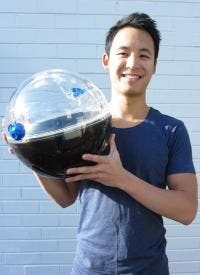A Monash University grad student has managed to create a simple, sustainable and affordable water purification device with the potential to save an incredible number of lives and eradicate diseases.
The Solarball, as it is called, was developed by Mr Jonathan Liow as his final year project in his Bachelor of Industrial Design can produce up to three liters of clear, drinkable water per day. What happens is the spherical unit absorbs sunlight and causes the dirty water to evaporate; as the evaporation occurs, contaminants are separated from the clean water, which is then condensed, and ready for drinking.
The Solarball was created with 900 million people who don’t have access to clean water in mind.
‘After visiting Cambodia in 2008, and seeing the immense lack of everyday products we take for granted, I was inspired to use my design skills to help others,’ Mr Liow said.
The simple and effective design is also extremely easy to use and sturdy, with a weather resistant shell, making it very appropriate for people who live in hot areas, where water shortages are most likely.
‘The challenge was coming up with a way to make the device more efficient than other products available, without making it too complicated, expensive, or technical,’ Mr Liow said.
Hopefully, the prototype will be improved, because there probably is room for that, and we will pretty soon see a mass production of the Solarball.











